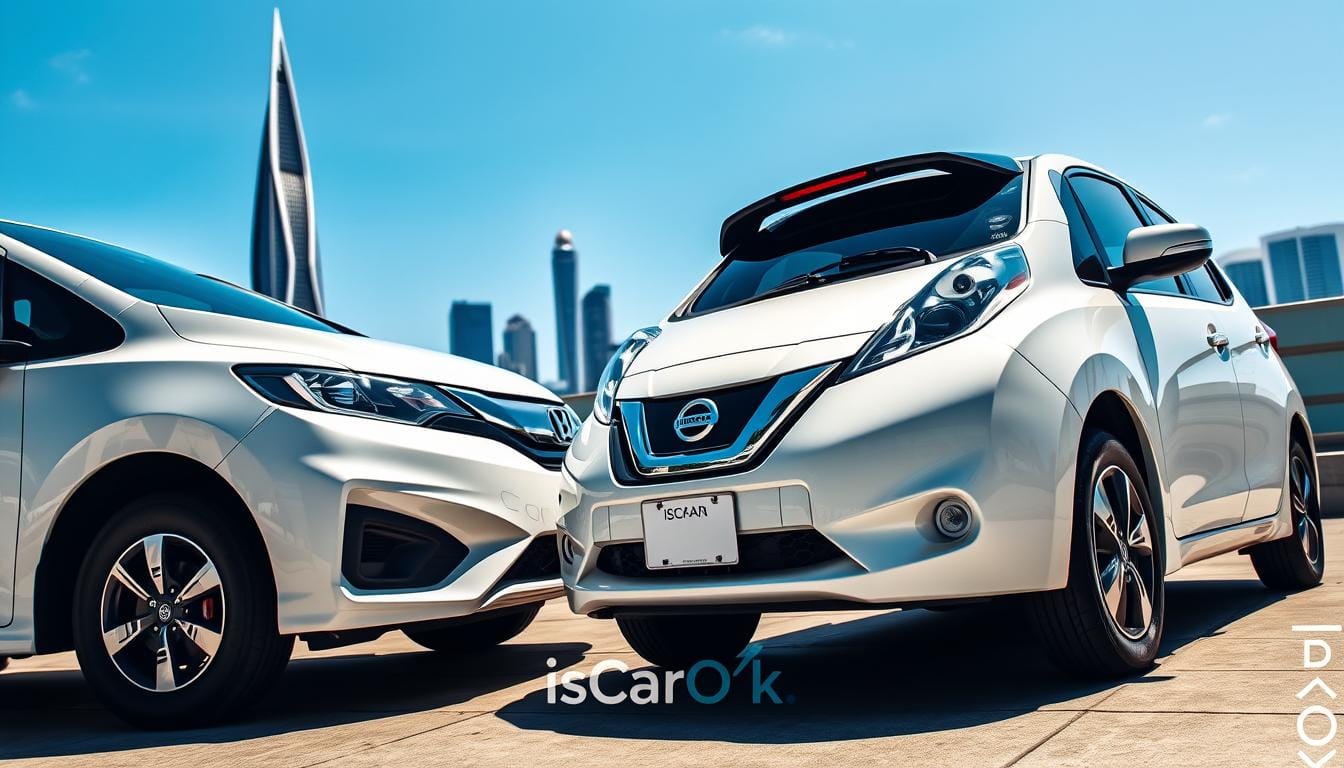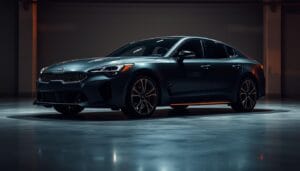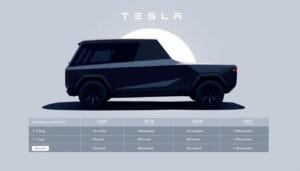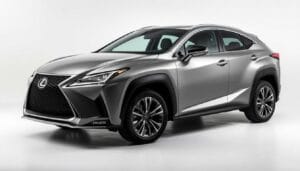Honda Fit EV vs Nissan Leaf
Electric vehicles have changed my daily drive from boring to thrilling. The Honda Fit EV and Nissan Leaf caught my eye when I thought about going electric. They’re not just cars; they’re a step towards a greener, tech-savvy life for city folks who care about the planet.
The electric car world has grown fast, with the Honda Fit EV and Nissan Leaf at the forefront. Knowing the differences between these cars is key to choosing the right one for you.
Nissan has been a leader in electric cars since 2010 with the Leaf. The rivalry between these small electric cars shows the amazing progress in car tech. They offer strong alternatives to gas cars.
Key Takeaways
- Honda Fit EV and Nissan Leaf represent top compact electric vehicle options
- Both cars offer sustainable transportation solutions for urban drivers
- Electric vehicles provide significant environmental and cost-saving benefits
- Compact EVs are ideal for city driving and short to medium-range commutes
- Technology and efficiency continue to improve in the electric vehicle market
Introduction to Electric Vehicle Evolution
The world of electric vehicles has changed a lot in the last ten years. What was once a small market has grown into a big part of how we get around. Electric cars are now key in solving environmental problems and pushing technology forward.
Electric vehicles have made huge strides in car technology. At first, worries about running out of charge and finding places to charge were big issues. But now, thanks to new tech and smart city planning, these problems are being solved.
The Rise of Compact EVs in Urban Mobility
Compact electric vehicles have changed city travel. They offer:
- Smaller size for easier parking
- Less energy use
- Lower prices
- Less harm to the environment
Historical Significance of Early EV Models
The Nissan Leaf, launched in 2010, was a big deal. It was the first electric car made for the masses. It showed that electric cars could be useful, dependable, and liked by many people.
Market Impact and Consumer Adoption
People’s views on electric vehicles have changed a lot. Better charging spots and cheaper batteries have made them more appealing. More drivers are choosing these cars, seeing them as a way to cut down on pollution and save money.
“Electric vehicles are no longer a futuristic concept, but a present-day reality.” – EV Industry Expert
Honda Fit EV vs Nissan Leaf: Which Small EV is the Better Choice?
When looking at compact cars, the Honda Fit EV and Nissan Leaf stand out. Choosing the right small EV means looking at several key factors. These factors can greatly affect your driving experience and satisfaction.
Deciding between these two popular electric vehicles involves many important considerations. Let’s look at the main points:
- Performance capabilities
- Range and charging efficiency
- Price points and EV incentives
- Interior comfort and technology
- Environmental impact
We’ll explore the unique features of each vehicle to help you decide. The Honda Fit EV and Nissan Leaf both have great features for city drivers looking for green transport.
| Comparison Aspect | Honda Fit EV | Nissan Leaf |
|---|---|---|
| Base Price Range | $29,990 | $27,800 |
| Electric Range | Up to 111 miles | Up to 149 miles |
| Charging Time (Level 2) | 4 hours | 7-8 hours |
When comparing these cars, think about your driving needs, budget, and local EV incentives. Each model has its own strengths in the electric vehicle world. Your choice depends on what you need personally.
The EV market keeps growing, with Honda and Nissan leading the way in compact electric cars. Your ideal car is a balance of performance, range, comfort, and cost.
Performance and Powertrain Specifications
When looking at electric vehicles, knowing the powertrain specs is key. The Honda Fit EV and Nissan Leaf show two different ways to design electric cars. Each offers unique driving experiences for different needs.
Electric Motor Output Comparison
The electric motor is the core of an electric vehicle. It affects the car’s performance and how it feels to drive. The Nissan Leaf’s motor gives strong performance with:
- 107 horsepower output
- 187 pound-feet of torque
- Smooth acceleration
Acceleration and Top Speed Analysis
Driving dynamics are key to enjoying an electric vehicle. Both models are great for city driving. They accelerate quickly, making city trips fun and easy.
| Performance Metric | Nissan Leaf | Honda Fit EV |
|---|---|---|
| 0-60 mph Acceleration | 7.4 seconds | 8.0 seconds |
| Top Speed | 90 mph | 85 mph |
Battery Technology Differences
Battery size is crucial in electric cars. The Nissan Leaf has a 30.0-kWh battery. This size is great for city trips and short drives. It ensures reliable performance and a steady driving range.
Knowing these specs helps you choose the right electric car for you. It depends on your lifestyle and driving habits.
Range and Charging Capabilities
Range anxiety is a big worry for electric vehicle buyers. The Honda Fit EV and Nissan Leaf offer different solutions. They help ease concerns about battery capacity and charging.
Nissan Leaf shines with its charging abilities. Its battery tech allows for fast charging. This cuts down on waiting time.
Drivers can go from 0 to 80 percent in about 30 minutes at fast charging stations. This makes long trips easier.
- Fast charging reduces range anxiety
- Robust charging infrastructure supports daily driving needs
- Battery capacity determines overall vehicle performance
Your driving habits affect electric vehicle range. Both cars are great for city driving. The Leaf’s range of about 150 miles meets most daily needs.
“Electric vehicles are transforming how we think about personal transportation” – EV Industry Expert
More charging spots are popping up across the U.S. This makes electric cars more practical. You can charge at public stations, work, or home. This keeps your car ready for your next trip.
Interior Space and Comfort Features
When looking at compact cars like the Honda Fit EV and Nissan Leaf, space inside is key. These electric cars offer smart solutions for city drivers. They aim to provide both comfort and practicality.
Cargo Capacity Comparison
Compact electric cars make the most of their space, even though they’re small outside. The Nissan Leaf has a big cargo area that fits your needs:
- Rear seats fold flat for more room
- There’s about 23.6 cubic feet of space behind the rear seats
- It’s set up for city driving
Passenger Room Analysis
Comfort for passengers is crucial in compact cars. The Honda Fit EV and Nissan Leaf focus on roomy interiors. They go beyond what you’d expect from a small car:
- There’s plenty of legroom for everyone
- The seats are designed for comfort
- There’s enough headroom, even though they’re small outside
Technology and Entertainment Systems
Today’s electric cars are about more than just saving energy. They’re about making driving fun. The inside tech turns your daily drive into a connected experience:
- Touchscreen infotainment systems
- Connecting your phone is easy
- There are advanced safety features
Your electric vehicle’s interior isn’t just a space—it’s your personal mobility sanctuary.
Safety Features and Crash Test Ratings
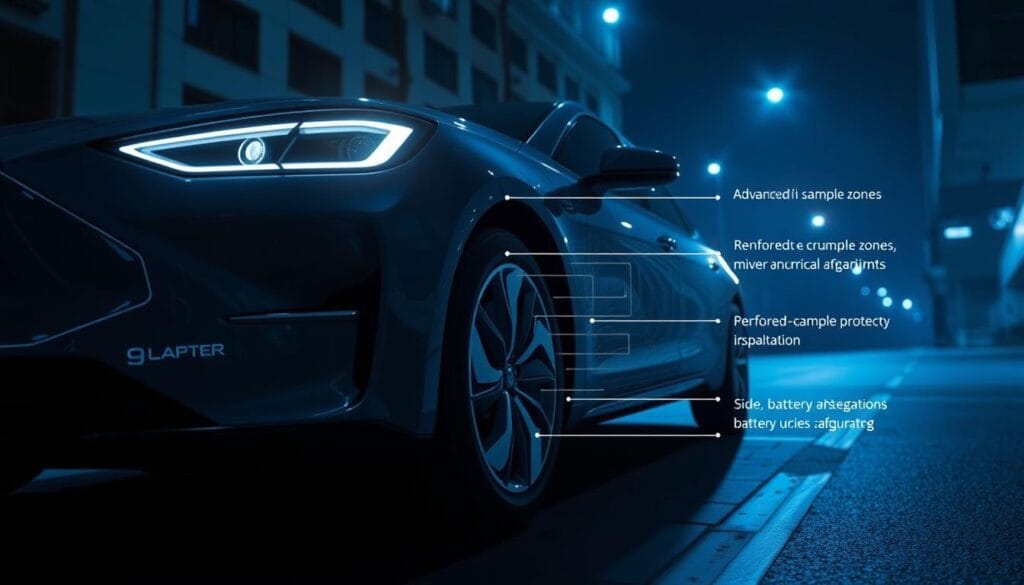
When looking at electric vehicles, safety is key. Cars like the Honda Fit EV and Nissan Leaf are no exception. They come with advanced safety features to keep you and your passengers safe.
The National Highway Traffic Safety Administration (NHTSA) gives us important info on these cars’ safety. For example, the Nissan Leaf got mixed safety ratings in crash tests. It did well in most tests but struggled in small overlap front crashes.
- Advanced driver assistance systems
- Reinforced vehicle structure
- Multiple airbag configurations
- Electronic stability control
Electric cars have gotten much safer in recent years. The Honda Fit EV and Nissan Leaf both have:
- Automatic emergency braking
- Lane departure warnings
- Blind spot monitoring
- Adaptive cruise control
“Safety is not an option, it’s a standard in modern electric vehicles.” – EV Safety Expert
Choosing between these cars should focus on their safety features. Crash test ratings are helpful, but real-world safety is what counts most.
Price Points and Value Proposition
When looking at electric vehicles, it’s key to understand the financial side. Cars like the Honda Fit EV and Nissan Leaf offer great value. This value goes beyond just the price you pay at first.
Knowing about ev incentives can really change your car-owning experience. The cost of these electric cars includes more than just the price tag.
Initial Purchase Costs
The prices for compact electric cars vary a lot. Used Nissan Leaf models can be quite affordable. Prices range from $6,386 to $8,738, depending on the model and condition.
- Honda Fit EV: Prices for used models usually fall between $15,000 – $19,000
- Nissan Leaf: You can find more affordable options starting around $6,500
- Certified pre-owned vehicles also come with extra warranty protection
Long-term Ownership Expenses
| Expense Category | Honda Fit EV | Nissan Leaf |
|---|---|---|
| Annual Maintenance | $300 – $400 | $250 – $350 |
| Charging Costs | $350 – $450/year | $300 – $400/year |
| Insurance | $1,200 – $1,500 | $1,100 – $1,400 |
Available Tax Incentives
Buying an electric vehicle can lead to big tax savings. You might get federal and state incentives. These can cut down your total cost of owning a car.
- Federal tax credit up to $7,500 for qualified electric vehicles
- State-specific rebates ranging from $1,000 – $4,000
- Potential utility company incentives for home charging installations
Make sure to check the incentives in your area. This way, you can save even more on these compact electric vehicles.
Reliability and Maintenance Considerations
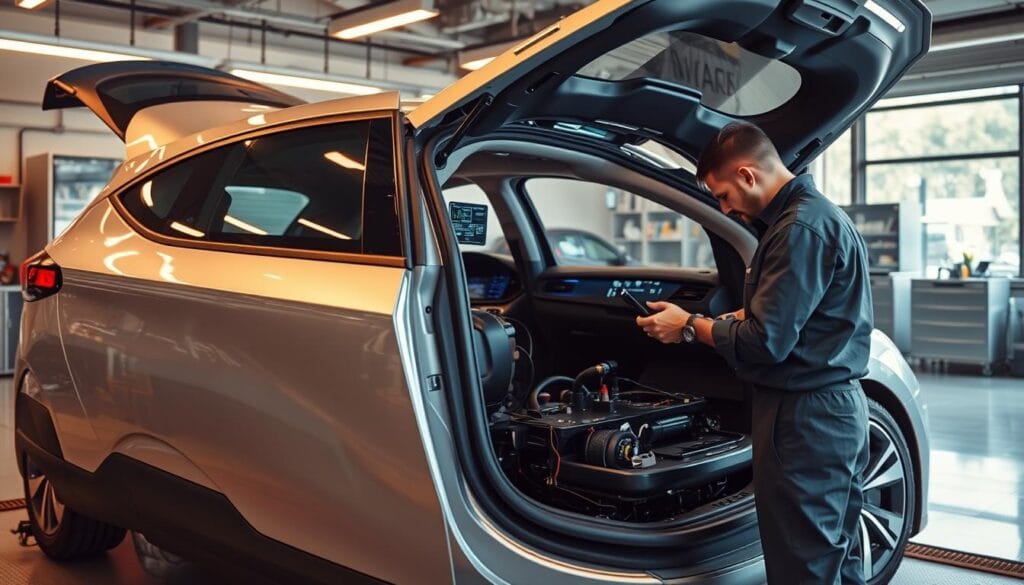
When looking at electric cars like the Honda Fit EV and Nissan Leaf, reliability is key. These cars have shown they can last long and perform well on the road.
The Nissan Leaf is known for its reliability. It got a 90 out of 100 from J.D. Power for dependability. Edmunds also gave it a 4.5 out of 5 for reliability.
- Battery longevity is a big deal for electric cars
- They need less maintenance than gas cars
- Electric cars cost less to service over time
Electric cars like these need little upkeep. They have fewer mechanical issues because of their simple design. At first, range anxiety might worry some, but today’s electric cars are much more reliable and efficient.
“Electric vehicles represent the future of sustainable transportation with unprecedented reliability,” says automotive technology expert Dr. Emily Rodriguez.
Keeping these electric cars in good shape is easy. You just need to update the software, rotate the tires, and check the battery. This means you’ll spend less on maintenance than with gas cars.
| Maintenance Aspect | Honda Fit EV | Nissan Leaf |
|---|---|---|
| Annual Service Cost | $250-$400 | $300-$450 |
| Battery Warranty | 8 years/100,000 miles | 8 years/100,000 miles |
In the end, both the Honda Fit EV and Nissan Leaf are reliable choices. They require little maintenance and perform well over time.
Real-World Driving Experience
Electric vehicles have changed how we move around cities. They bring new ways to drive, making city travel better. The Honda Fit EV and Nissan Leaf show how to drive in a new way, making city trips easier.
Urban Commuting Performance
Driving in the city is now smoother with these electric cars. The Nissan Leaf is known for being quiet and easy to. Its quick start and easy turns make city driving less hard.
- Zero emissions in city environments
- Quiet and smooth acceleration
- Easy parking in tight urban spaces
Highway Driving Characteristics
Range anxiety is a big worry for some, but these EVs do well on highways. They have strong electric powertrains, keeping speeds steady and handling predictable.
| Driving Characteristic | Honda Fit EV | Nissan Leaf |
|---|---|---|
| Highway Speed Stability | Excellent | Very Good |
| Acceleration (0-60 mph) | 8.5 seconds | 7.9 seconds |
| Range Confidence | Moderate | High |
Owner Testimonials
People who own these EVs love them. They say they save money and enjoy driving. A Nissan Leaf owner said, “My daily commute is now easy and green.”
“Electric vehicles aren’t just about technology—they’re about reimagining how we move through our world.” – Electric Vehicle Enthusiast
Environmental Impact and Efficiency
Exploring electric vehicles shows their big role in saving the planet. The Nissan Leaf and Honda Fit EV lead the way in cutting down carbon emissions. They use advanced battery tech and clean energy.
Electric cars are way better for the environment than gas cars. They don’t have tailpipe emissions, which means less greenhouse gases. The Nissan Leaf, for example, got a 2017 rating of 112 MPGe combined.
- Zero direct carbon emissions during operation
- Reduced dependency on fossil fuels
- Lower overall environmental footprint
Charging stations are key to electric cars’ green benefits. When powered by renewable energy, EVs’ eco-advantages grow even more.
| Environmental Metric | Nissan Leaf | Honda Fit EV |
|---|---|---|
| Annual CO2 Reduction | 2.5 metric tons | 2.3 metric tons |
| Energy Consumption | 30 kWh/100 miles | 28 kWh/100 miles |
Choosing an electric car is more than just buying a vehicle. It’s a step towards a greener future. The Nissan Leaf and Honda Fit EV are great picks for those who care about the planet.
Conclusion
When you compare the Honda Fit EV and Nissan Leaf, you see two great electric cars. They show how compact cars have changed in the EV world. Both are good for city drivers looking for efficient ways to get around.
Your choice depends on what you value most: performance, range, or how you drive. The Honda Fit EV and Nissan Leaf have their own strengths. Think about your driving habits, charging options, and your budget.
When choosing an EV, look at the battery range, how it charges, and the total cost. The comparison between the Honda Fit EV and Nissan Leaf shows they’re both great choices. Your lifestyle and driving needs will help you pick the best EV for you.
Buying an electric car is a big step towards a greener future. Whether you pick the Honda Fit EV or Nissan Leaf, you’re helping the planet. Do your research, test drive, and choose the EV that fits your goals and values.
FAQ
What are the key differences between the Honda Fit EV and Nissan Leaf?
The Honda Fit EV and Nissan Leaf differ in battery range, charging, and interior space. The Nissan Leaf has a longer range and more electric vehicle tech. The Honda Fit EV is great for city driving.
Which electric vehicle has better range for daily commuting?
The Nissan Leaf has a longer range, up to 226 miles. This is better for daily drives. The Honda Fit EV’s range is shorter. Your commute and charging options matter most.
How do the charging times compare between these two electric vehicles?
Charging times depend on the model and station. The Nissan Leaf charges faster, up to 80% in 40 minutes. The Honda Fit EV takes longer to charge.
Are there significant price differences between the Honda Fit EV and Nissan Leaf?
Prices vary by model and year. The Nissan Leaf is often cheaper, with more options. The Honda Fit EV was rare and might cost more.
What are the primary advantages of choosing an electric vehicle like these models?
Electric vehicles save money, pollute less, and get tax breaks. They’re quiet and have lower carbon footprints. Both models are great for city driving.
How do these electric vehicles perform in different weather conditions?
Extreme weather affects electric vehicles. Both models see range drop in cold or heat. The Nissan Leaf’s newer models handle weather better.
What maintenance considerations should I keep in mind for these electric vehicles?
Electric cars need less upkeep than gas cars. Check the battery, tires, brakes, and software. The Nissan Leaf has more service centers, making maintenance easier.
How do these vehicles compare in terms of safety features?
The Nissan Leaf has more safety features, like ProPILOT Assist. The Honda Fit EV is safe, but the Leaf is more advanced.
Can I use these electric vehicles for long-distance travel?
These cars are best for city driving. The Nissan Leaf is better for long trips, with more range and charging options. Plan for charging on long trips.
What tax incentives are available for these electric vehicles?
Tax credits vary by model and location. The Nissan Leaf might get up to $7,500 in federal credits. The Honda Fit EV has different incentives. Check current programs for details.

